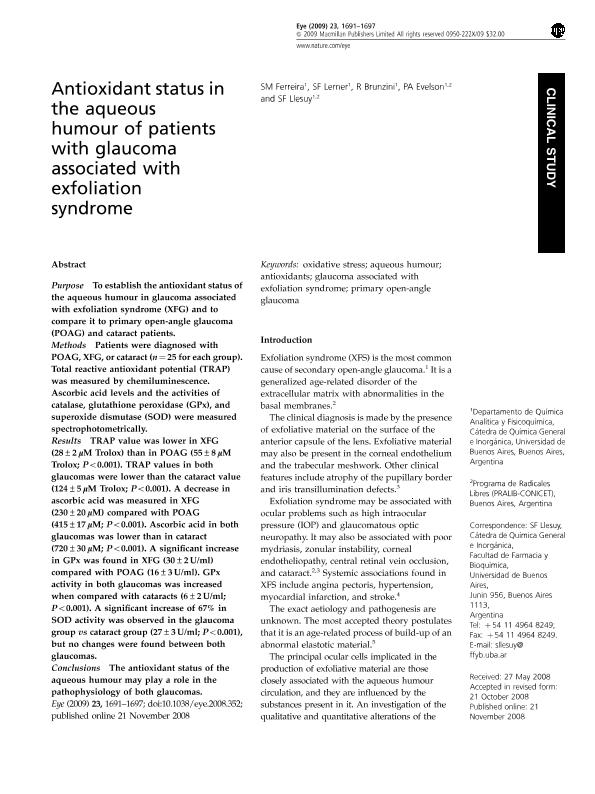Artículo
Antioxidant status in the aqueous humour of patients with glaucoma associated with exfoliation syndrome
Fecha de publicación:
12/2009
Editorial:
Nature Publishing Group
Revista:
Eye
ISSN:
0950-222X
Idioma:
Inglés
Tipo de recurso:
Artículo publicado
Clasificación temática:
Resumen
PURPOSE: To establish the antioxidant status of the aqueous humour in glaucoma associated with exfoliation syndrome (XFG) and to compare it to primary open-angle glaucoma (POAG) and cataract patients. METHODS: Patients were diagnosed with POAG, XFG, or cataract (n=25 for each group). Total reactive antioxidant potential (TRAP) was measured by chemiluminescence. Ascorbic acid levels and the activities of catalase, glutathione peroxidase (GPx), and superoxide dismutase (SOD) were measured spectrophotometrically.ResultsTRAP value was lower in XFG (28+/-2 microM Trolox) than in POAG (55+/-8 microM Trolox; P<0.001). TRAP values in both glaucomas were lower than the cataract value (124+/-5 microM Trolox; P<0.001). A decrease in ascorbic acid was measured in XFG (230+/-20 microM) compared with POAG (415+/-17 microM; P<0.001). Ascorbic acid in both glaucomas was lower than in cataract (720+/-30 microM; P<0.001). A significant increase in GPx was found in XFG (30+/-2 U/ml) compared with POAG (16+/-3 U/ml). GPx activity in both glaucomas was increased when compared with cataracts (6+/-2 U/ml; P<0.001). A significant increase of 67% in SOD activity was observed in the glaucoma group vscataract group (27+/-3 U/ml; P<0.001), but no changes were found between both glaucomas. CONCLUSIONS: The antioxidant status of the aqueous humour may play a role in the pathophysiology of both glaucomas.
Archivos asociados
Licencia
Identificadores
Colecciones
Articulos(IBIMOL)
Articulos de INSTITUTO DE BIOQUIMICA Y MEDICINA MOLECULAR
Articulos de INSTITUTO DE BIOQUIMICA Y MEDICINA MOLECULAR
Citación
Ferreira, Sandra María; Lerner, S.F; Brunzini, R; Evelson, Pablo Andrés; Llesuy, Susana Francisca; Antioxidant status in the aqueous humour of patients with glaucoma associated with exfoliation syndrome; Nature Publishing Group; Eye; 23; 12-2009; 1691-1697
Compartir




